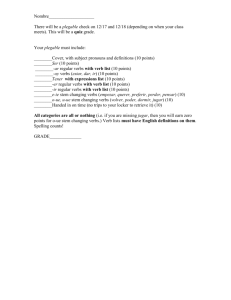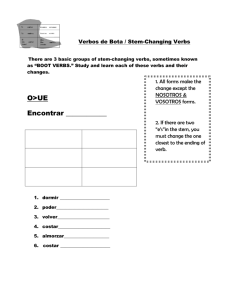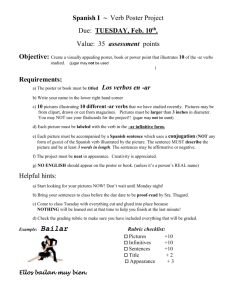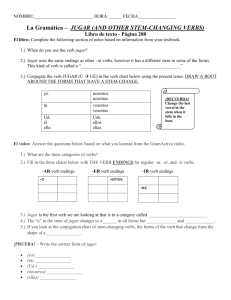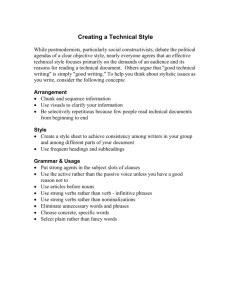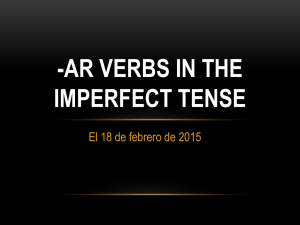Stem-Changing (e-->ie) - ¡Bienvenidos a la clase de Español!
advertisement
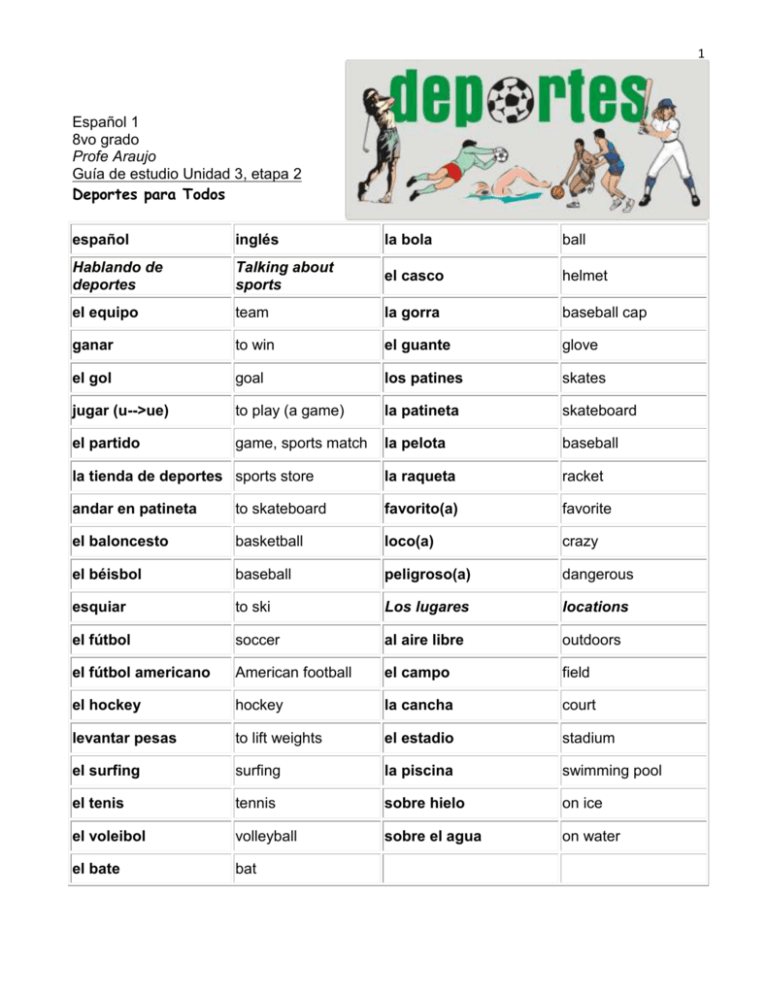
1 Español 1 8vo grado Profe Araujo Guía de estudio Unidad 3, etapa 2 Deportes para Todos español inglés la bola ball Hablando de deportes Talking about sports el casco helmet el equipo team la gorra baseball cap ganar to win el guante glove el gol goal los patines skates jugar (u-->ue) to play (a game) la patineta skateboard el partido game, sports match la pelota baseball la tienda de deportes sports store la raqueta racket andar en patineta to skateboard favorito(a) favorite el baloncesto basketball loco(a) crazy el béisbol baseball peligroso(a) dangerous esquiar to ski Los lugares locations el fútbol soccer al aire libre outdoors el fútbol americano American football el campo field el hockey hockey la cancha court levantar pesas to lift weights el estadio stadium el surfing surfing la piscina swimming pool el tenis tennis sobre hielo on ice el voleibol volleyball sobre el agua on water el bate bat 2 Grammar Summary Talking About Playing a Sport or Game with jugar The forms of jugar are unique. In some of them the u changes to ue. When you use jugar with the name of a sport, use jugar + a + sport: Juego al béisbol. JUGAR: Yo nosotros (as) Tú Vosotros (as) Él Ella Usted Ellos Ellas Ustedes Using gustar + Infinitive You already learned how to use gustar to say I like, you like and he/she likes to do something. Now you can talk about what other people like to do: IO Pronoun + GUSTAR + Infinitive I like = me gusta jugar béisbol (The short words in red in the table above are called "indirect object pronouns." They are used to indicate "to whom" or "for whom" an action is performed. Remember that with gustar the action or thing you like is the subject of the sentence and controls how the verb is conjugated. So the sentence me gusta jugar béisbol translates literally as "to play béisbol is pleasing to me.") When you want to emphasize or identify the person that you are speaking about, use: a + name/noun/pronoun in front of the pattern in the table above: A + person +IO pronoun + GUSTAR + Infinitive I like = A mí me gusta jugar al béisbol 3 Write 5 complete sentences using the verb jugar along with IDOP. Don’t forget to use the specific form. 1. 2. 3. 4. 5. Stem-Changing Verbs (E --> IE) When you learn one of these "stem-changing verbs" the change is indicated in parentheses after the verb. For example: cerrar (ie) - to close. In stem-changing verbs it is always the next-to-last syllable that changes, but only when the STRESS falls on that syllable. For example with cerrar, yo cIErro, but nosotros cerramos. These are sometimes called "boot" verbs, because when you look at the conjugation chart, the forms that have a spelling change would look like a boot if you drew a line around them: CERRAR: Yo nosotros (as) Tú Vosotros (as) Él Ella Usted Ellos Ellas Ustedes Stem-Changing (e-->ie) Verbs in This Lesson (Look at your verb chart for the conjugation of each of the following verbs) cerrar empezar Entender + QUE merendar perder Preferir + QUE querer + QUE Pensar + QUE 4 Saying What You Know with saber You already know how to say "I know (a person or place):" ___________________ (person). Saber is used when you want to say "I know (facts, information or how to...)." Like conocer, it has an irregular yo form. CONOCER: Yo nosotros (as) Tú Vosotros (as) Él Ella Usted Ellos Ellas Ustedes SABER: Yo nosotros (as) Tú Vosotros (as) Él Ella Usted Ellos Ellas Ustedes Using Two Verbs Together To say that someone knows how to do something, use saber + infinitive: Yo sé patinar - I know how to skate. Notice that when two verbs are used together, the first verb is conjugated and the second is in its infinitive form. Usually this is obvious from the English meaning of "to...." as in the sentence "I want to eat. = Yo quiero comer." Using "a" for Action When Using Two Verbs Together Another useful thing to remember about using two verbs together is that a conjugated verb that involves an "action" will usually have the word "a" between it and the infinitive. Verbs that don't involve an "action" (such as "I know" or "I plan") do not. Usually these NOT verbs involve something "inside your head." ACTION No ACTION I'm going to play = Voy a jugar I'm beginning to play = Empiezo a jugar I'm planning to play = Pienso jugar I want to play = Quiero jugar I'm coming to play = vengo a jugar I prefer to play = prefiero jugar I'm teaching to play = enseño a jugar I know how to play = sé jugar I'm preparing to play = preparo a jugar I can play = Puedo jugar 5 Phrases for Making Comparisons There are several phrases for making comparisons. We have two formulas in Spanish. Comparative: Subject/noun #1+ verb to be (SER)+más OR menos +adjective+ QUE +noun#2 (Agrees in Gender and number) Ej: Superlative: Subject + verb to be (SER) + article: el OR la + más OR menos + adj +DE (Agrees in Gender and number) Ej: Irregulars: yonger older Best/better worse We also have: as much as Ej: as +adjective+ as Ej: OJO When you talk about numbers, you must use más or menos then DE not que. For example: Hay más que de quince estudiantes en la clase de español. Hay más que de siete personas en el equipo de béisbol.
